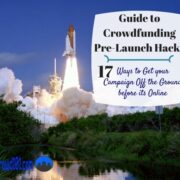Building Community in Crowdfunding: Must Know Rules
Building community for your crowdfunding campaign is one of the most overlooked but critical aspects of raising money online.
The explosion in crowdfunding, especially for rewards-based projects, over the last several years has made people think that raising money is as simple as posting a project on one of the popular sites. A couple of days are spent putting together a proposal and a brief budget. The project is posted and the entrepreneur waits for the money to roll in.
And then they wait, and wait, and wait until they reach the project deadline and close it out discouraged. This is what happens to more than 60% of projects.
Why? In crowdfunding, just because you build it does not necessarily mean backers will come.
What is Community in Crowdfunding?
One of the biggest mistakes crowdfunders make is that of not creating a community, rather than an audience. Marketing classes in school are singularly focused on ‘reaching your audience’ and getting your message across. The average American sees as many as 4,000 ads a day; so many that we have learned to subconsciously ignore them. Billion-dollar corporations pay big bucks just to break through that subconscious roadblock and get the message across to their target audience.
Buy you don’t have a billion dollars. If you cannot reach hundreds of thousands with traditional marketing mega-bucks then you need the power of building community in crowdfunding. This is something I talked about in another post about getting the most from your crowdfunding marketing.
Understand that building community in crowdfunding is more than just getting people to click that they ‘Like’ your Facebook page. Building a community is about establishing a relationship through interaction and trust. It is about sharing real value and goals. When your crowdfunding community shares your vision and your goals for the project, they’ll push just as hard as you do to reach the funding goal.
How to Build a Crowdfunding Community
Communication is the key to building community in crowdfunding. We’ve all been there. You just put down a big chunk of money for something and now you are wondering if it was a mistake. Buyer’s remorse!
You need to contact each of your funders to your project as soon as possible after they donate or invest. Reinforce those ideas that led them to donate or invest and overcome their buyer’s remorse. This is most easily done with an auto-respond message that strikes an emotional cord and hits on your key points. If you really want to build community though, aim for a personal call within 24 hours. I like the iContact.com email service for its extra features beyond the standard autoresponder, plus it offers a free 30-day trial so there’s no risk.
Try iContact for 30 days Free!
It doesn’t stop there. Plan a series of contacts that you go through with every funder. Follow the call with an email the next day that addresses any questions (you need to ask them and be listening for any doubts or questions) and reinforces the key points in your project. The longer you can keep that emotional appeal in their mind, the more they will grow to support your project.
After your initial contact and email, give them a few days then send another email asking for a favor. Make it something relatively small like sharing an email with three of their closest friends. The more someone does for your project, the more they share themselves, then the closer they will feel to the project and will make its goals their own.
If you get a rejection to your request or the funder did not follow through with it, ask for something else. Researchers at Stanford found that people are much more likely to say yes to a favor after rejecting an initial request. We have an inner need to be liked and help others. The guilt of rejecting someone not once, but twice is too much for many people.
After a request or two, gauge your supporter’s commitment with another phone call. Talk to them about a problem you have been experiencing and ask their advice. You may even go so far as to ask them to help review or revise a detail of the project. Anything to make them feel that they are a part of the project, that they have a level of ownership and a motive to get it funded.
If they are eager to help, they may be ready for a bigger role in the community. Talk to them about how important it is to get ‘our’ project funded and how it will make a difference. Talk with them about how important it is that other people know of the project.
Overcome your natural hesitation to be “pushy,” there’s no place for it as a small business owner. If you are truly passionate about your company or cause, it will show through and your perseverance will pay off.
Some in your community will become independent marketers and will need less reinforcement or guidance. You’ll still need to touch base every once in a while to keep them motivated and involved but the interaction will be minimal to the benefit they will bring. Others in your community will be just as enthusiastic but will need more guidance.
Crowdfunding Social Networking
 They say that a person needs to see something seven times before it is converted to long-term memory. With social media and the onslaught of virtual requests on the internet, I would bet this number is much higher. That is why you have to make your social networking campaign completely integrated and redundant. This kind of social media engagement would be impossible without a social media management tool like Hootsuite Pro
They say that a person needs to see something seven times before it is converted to long-term memory. With social media and the onslaught of virtual requests on the internet, I would bet this number is much higher. That is why you have to make your social networking campaign completely integrated and redundant. This kind of social media engagement would be impossible without a social media management tool like Hootsuite Pro. The site allows you to link all your social media accounts and schedule messages from one page. You can even reply to messages from the dashboard making social media marketing much faster and easier.
- Update all your personal profiles to include a description of the project and a link that directs to either your project website or directly to the campaign page on the crowdfunding platform
- Add a button or clickable text signature to your email accounts
- Consider making a series of YouTube videos that you can post on Facebook and your project website. Make sure you provide links within the video to your campaign
- Make regular Facebook status updates within your personal profile as well as the project’s profile
- Post information on the Facebook pages of related groups or organizations
- Comment on blog posts of subjects related to your project and provide a link back to your website or campaign. Make sure your comment is relevant to the blog post or it could be considered as spam.
- Make sure you respond to any comments on your own blog or website
- Keep updated on any news related to your project and pass it along through your network
- Consider other social media sites besides Facebook as well, for example: LinkedIn, Pinterest, Twitter, Google+, Instagram, Flickr, Vine, Meetup, Tagged, Ask.fm and Classmates
- Watch out for crowdfunding promotion and consultants that promise the world. I wrote about how to avoid crowdfunding promotion scams in another post.
Some final thoughts on building your crowdfunding community
- Provide a virtual button to funders that says, “I support project XYZ,” and ask them to display it in their email signature and on their social networking pages. This can be a string of text that links to your project page but a small image works best.
- Depending on the geographical reach of your community, you may be able to meet face-to-face with the most motivated in your group. A personal visit is even more powerful in our world of clicks and likes. Try working your way up from a quick coffee to helping them host a dinner party to reach out to others.
- If you have the ability and budget, a forum on your website can be a giant leap to building community. This will not only help exchange ideas but will help your community motivate each other with less direction from you.
- Your own budget and how many supporters you need will determine how you build your community. The best method is through regular phone calls and personalized emails but this may not be possible with a small budget and many funders. If your budget supports it, try hiring someone to help make those community contacts but make sure they share your passion for the project.
Ready to start crowdfunding? Check out the Ultimate List of Crowdfunding and Fundraising Websites.
Crowdfunding doesn’t stop at raising money and your community won’t just disappear when the campaign closes. Leverage your success to bring more people to your business website or to raise more money on new projects. Crowdfunding is a marketing phenomenon, allowing regular people to reach thousands and hundreds of thousands with their message and without spending billions in advertising.





